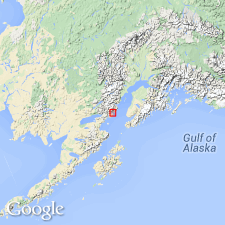
- Usage in publication:
-
- Red Glacier Formation*
- Modifications:
-
- Named
- Dominant lithology:
-
- Sandstone
- Shale
- AAPG geologic province:
-
- Alaska Southwestern region
Summary:
Pg. C30-C34. Red Glacier Formation, basal formation of Tuxedni Group (revised). Name replaces term lower member of former Tuxedni Formation in older reports. Consists mainly of arkosic sandstone and shale with minor amounts of subgraywacke-type sandstone, conglomerate, and limestone in lower part, and sandy siltstone in upper part. At type locality lower 200 feet is light-brown arkosic sandstone; this is overlain by 200 feet of black silty shale, 200 feet of arkosic sandstone, 1,000+ feet of soft black silty shale in which faults cut out part of section, 720 feet of light-brown arkosic sandstone, 1,060 feet of interbedded sandstone and siltstone, and at top by 1,160 feet of sandy siltstone. Underlies Gaikema Sandstone; contact gradational; unconformably overlies Talkeetna Formation of Early Jurassic age. Age is Middle Jurassic (Bajocian).
Type section (composite): along both sides of Red Glacier. Upper 3,310 ft exposed along south side, 4.5 mi S. 62 deg. E. of Diamna Volcano; lower 1,230 ft is on north side of glacier, 6.5 mi N. 86 deg. E. of Iliamna Volcano, [lower] Cook Inlet region, southwestern AK. Thickness 1,980 ft at Tuxedni Bay, 18 mi north of Red Glacier; about 6,500 ft thick in subsurface under Iniskin Peninsula. Named from Red Glacier.
Source: US geologic names lexicon (USGS Bull. 1350, p. 621-622); supplemental information from GNU records (USGS DDS-6; Menlo GNULEX).

- Usage in publication:
-
- Red Glacier Formation*
- Modifications:
-
- Overview
- AAPG geologic province:
-
- Alaska Southwestern region
Summary:
Pg. 21-24, pls. Red Glacier Formation of Tuxedni Group. From exposures on south shore of Tuxedni Bay, formation continues about S. 50 deg. W. in a well-defined belt 1 to 2.5 miles wide to valley of Boulder Creek. General structural trend of rock changes abruptly south of Boulder Creek; this change may be in part due to upwelling of liquid hot magma in Iliamna Volcano. Strike becomes more westerly, and beds are terminated on east slope of volcano by Bruin Bay fault or are covered by lava flows. Good exposures are present in bluffs on south shore of Chinitna Bay between mouth of Gaikema Creek and Marsh Creek tidal flat. Only upper part is present where these beds wrap around end of Tonnie syncline. Beds continue southwest along flanks of Tonnie syncline as far as Low Creek, where they are terminated by intersection of Low Creek cross fault and a branch of Bruin Bay fault. Maximum of about 300 feet is exposed at mouth of Tonnie Creek, where formation was faulted to its present position. Exposed parts of formation range in thickness from 2,000 to 4,500 feet. Overlies Horn Mountain Tuff Member (new) of Talkeetna Formation. Depositional contact with the Talkeetna rarely seen because in most exposures the Red Glacier is in fault contact relationship with older rocks. Age is Middle Jurassic.
Source: US geologic names lexicon (USGS Bull. 1350, p. 621-622).
For more information, please contact Nancy Stamm, Geologic Names Committee Secretary.
Asterisk (*) indicates published by U.S. Geological Survey authors.
"No current usage" (†) implies that a name has been abandoned or has fallen into disuse. Former usage and, if known, replacement name given in parentheses ( ).
Slash (/) indicates name conflicts with nomenclatural guidelines (CSN, 1933; ACSN, 1961, 1970; NACSN, 1983, 2005, 2021). May be explained within brackets ([ ]).

